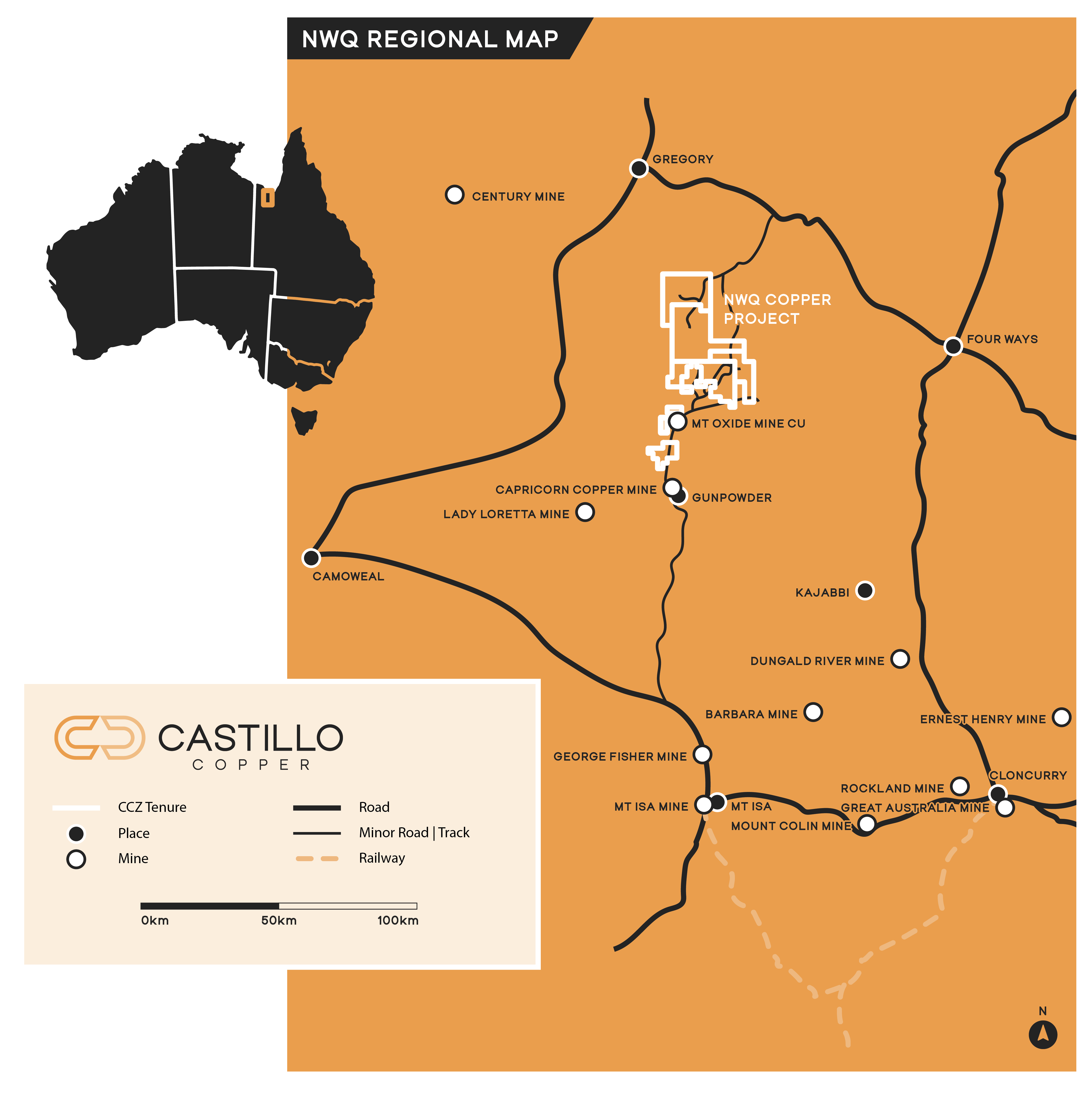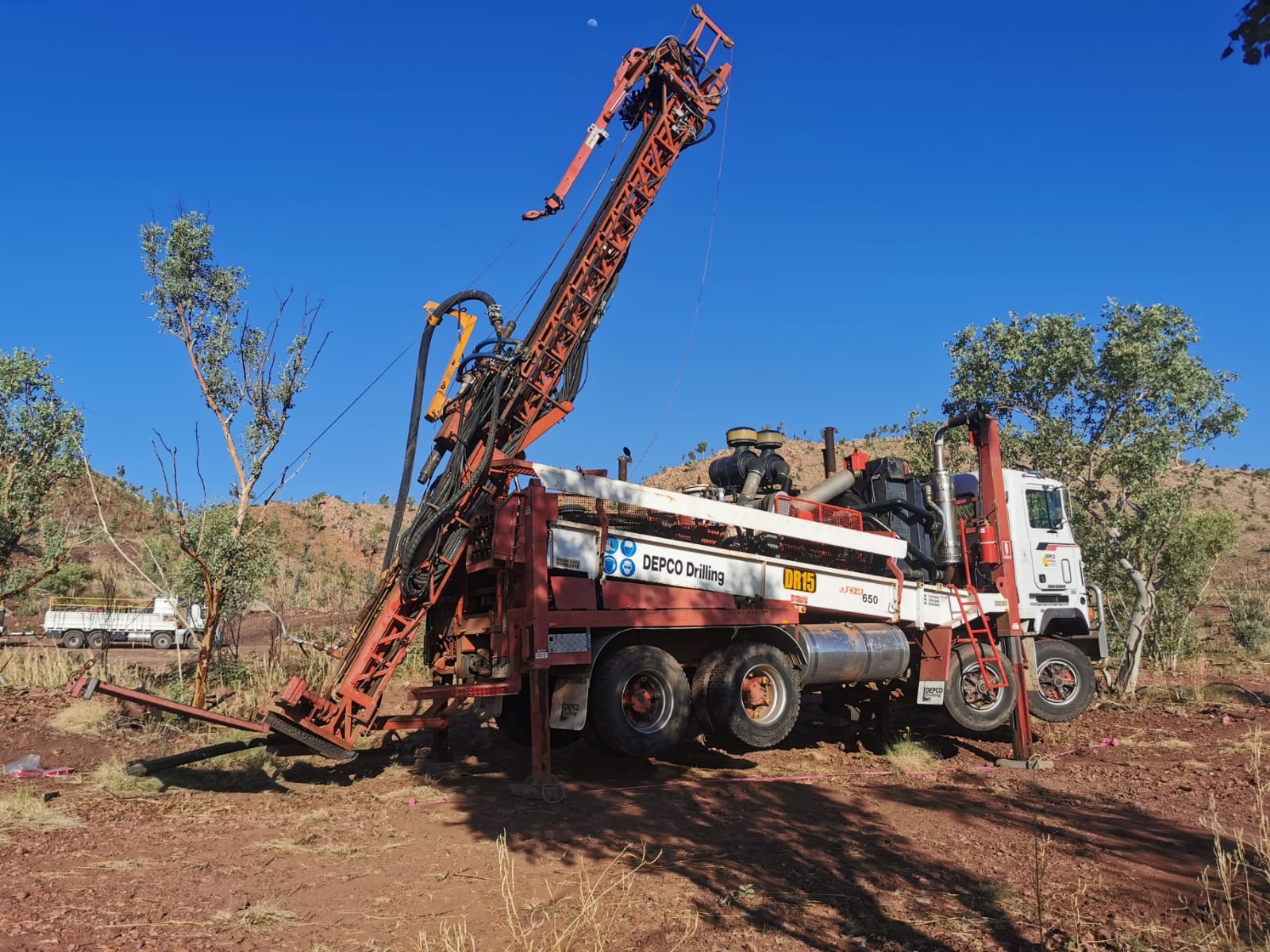LOCATION
Queensland, Australia
YEAR
Since March 2017
POTENTIAL
22 Targets
MINERALISATION
IOCG
Overview

Located in one of the world’s greatest high-grade concentrations of copper, zinc, lead and silver.
The Project is near to several historic / currently operating copper mines including Lady Annie, Mt Oxide and Capricorn Copper.
Extensive historical exploration database has provided Castillo Copper with 22 walk up targets, including the major ‘Big One’ copper discovery.
Big One JORC MRE:
2.1 Mt @ 1.1% Cu ~22kt contained Cu.
LOCATION
The NWQ Copper Project is located approximately 140kms north of Mount Isa in north-west Queensland.

Geology
The NWQ Copper Project comprises five mineral leases, covering a total area of 977km2.
Geologically, the Project area falls within the Mount Isa Inlier, a vast section of Proterozoic crustal rocks dating from 2.5 billion to 540 million years ago. The Mount Isa Inlier is known to host world-class shale-hosted lead-zinc-silver sulphide deposits such as the Mount Isa, Century, Hilton and George Fisher.
The region at large also features iron-rich deposits – including the Broken Hill Type – along with structurally controlled copper and gold deposits.
The project area, which straddles the Lawn Hill Platform and the Leichhardt River Fault Trough, is characterised by rock formations associated with known copper occurrences, including the Surprise Creek and Gunpowder Formations.
Additionally, the significant Mount Gordon Fault Zone, linked to the economic copper deposits at the nearby Capricorn Copper operations, intersects the project area.
EXPLORATION
Owing to its proximity to Mount Isa, along with various historical and active mines, the NWQ region has been extensively explored. Efforts to date have primarily targeted sedimentary hosted copper sulphide mineralisation.
In contrast, there has been minimal exploration for structurally hosted gold and other critical minerals and within the Project area. Similarly, historic drilling within the Project area has been limited.
There are at least twenty-two deposits or historical mine sites within the Project area. A summary of ten of the most studied prospects is as follows.
The Big One prospect, a recognised source of high-grade copper since mining activities commenced in 1914-15, has a rich history. Historical drill data reveals copper grades as high as 28.4% Cu.
In the early 1990s, an aerial geophysical survey identified a substantial sulphide anomaly, leading to the recommencement of small-scale mining operations in the mid-1990s. In 1997, 4,400 tonnes of supergene ore with an average copper grade of 3.5% was extracted. Shortly after, mining was again suspended due to falling commodity prices.
In 2021 and 2022 Castillo Copper conducted two drilling campaigns and an Induced Polarisation Survey, significantly expanding known mineralisation and confirming a substantial copper discovery.
Top intersects included:
- BH 303RC: 40m @ 1.64% Cu from surface incl: 11m @ 4.40% Cu from 24m, 5m @ 7.34% Cu from 28m & 1m @ 16.65% Cu from 29m
- BH 301RC: 44m @ 1.19% Cu from surface incl: 14m @ 3.55% Cu from 27m, 3m @ 10.88% Cu from 37m & 1m @ 12.6% Cu from 37m
- BH BO017: 34m @ 1.51% Cu from surface incl: 21m @ 2.25% Cu from surface, 12m @ 3.44% Cu from 3m, 6m @ 4.79% Cu from 3m and 1m @ 9.4% Cu from 9m
The high-grade mineralisation zone, confined within a dyke, exhibits a more vertical dip than expected. Recent modelling of the 2021 and 2022 drilling campaigns produced a maiden JORC 2012 compliant Mineral Resource Estimate (MRE) of 2.1 million tonnes at 1.1% Cu.
A follow-up drilling campaign aims to extend known mineralisation and enhance confidence/grade of the current MRE. The underlying orebody, starting from the surface, remains undefined and open to the east, north, and down dip.
Surface sampling campaigns have returned up to 5,400ppm Cu in rock chip samples from the historically mined Eldorado South Prospect, suggesting the presence of a structurally controlled copper-gold system.
Follow-up field investigations will identify if this system is associated with a nearby major NNE trending fault.
The Valparasia Prospect consists of copper mineralisation in two horizons over a 6km strike length. Previous explorers discovered rock chips with up to 2,530ppm Cu.
Reconciling geochemical data against the interaction of two intersecting faults suggests the presence of a structurally controlled copper system.
Located within the Mount Gordon Fault Zone, the Boomerang Prospect consists of outcropping copper oxide deposits, striking up to 800m. Boomerang has been the subject of a small scale, shallow historic drilling campaign, with deeper copper sulphide mineralisation potential untested.
Rock samples collected in September 2023 returned anomalous values up to 4590ppm Cu.
There is compelling evidence to support a systematic, prioritised follow-up surface sampling and geophysics campaigns to identify potential targets for drill-testing.
At the historic Mount Storm Prospect, a small-scale mining operation yielded approximately 700 metric tonnes of ore with a copper content of 7%.
Subsequent field investigations revealed the presence of copper and cobalt at the surface, with gold close by.
These findings suggest the possibility of a structurally controlled system associated with a porphyry dyke.
The Black Mountain Prospect comprises a copper anomaly, detected through stream sediment sampling and substantiated by signs of past mine workings.
Analysis of rock samples gathered from a ferro-manganiferous outcrop in 2021 revealed anomalous values, with copper reaching up to 940ppm Cu.
Additional rock sampling may be conducted to identify potential targets for drill-testing.
The Crescent Prospect shows promise for IOCG (Iron Oxide Copper Gold) deposits, supported by geochemical, geophysical and petrographic analysis.
Visible traces of gold and silver have also been found in the area. It is structurally controlled on the western side, with potential for IOCG-style mineralisation between faults and geophysical surveys have identified anomalies. Further on-ground investigation is merited.
The Pancake Prospect possesses Mount Isa style potential. Soil samples along an east-west trending anomalous zone delivered positive readings for zinc-lead-copper mineralisation.
As the geochemical data reconciles favourably with two sub-surface anomalies, identified with ground geophysics, they are targets for follow up drill-testing. Re-inspection and sampling of a 250m deep corehole stored in the Mount Isa Core Shed will deliver results with limited outlay.
The Wall Prospect is assessed to have the potential to host Mount Isa style mineral deposits. Soil geochemistry data reveals a zinc-lead-copper zone measuring approximately 400m by 225m, coinciding with an aerial electromagnetic anomaly.
Soil assay results retuned values of up to 7,163ppm Zn, 2,023ppm Pb and 1,464ppm Cu.
Additional rock or soil sampling has the potential to extend the area of known mineralisation.
At the Arya Prospect there is a significant magnetic anomaly, south of the drill-tested graphite system, which shows potential to be a primary source of copper mineralisation.
Further field work is recommended to determine the relationship between the structure and mineralisation, prior to a proof-of-concept campaign to drill-test the magnetic anomaly.
Note, any on-ground activity will require the establishment of an access track next to the Myally Creek, which will pose some challenges.
The Arya Prospect has a sizeable sulphide anomaly with IOCG potential. This bedrock conductor, which was discovered by an aero-electromagnetic survey in 2019, is 130m thick with dimensions of 1,500m by 450m. Outcropping copper mineralisation has also been found at surface.
A limited drilling campaign in late 2021, designed to test several large airborne electro-magnetic and ground resistivity anomalies, confirmed a low-grade (<2% total graphitic carbon) graphite system that won’t be further explored.
However, a sizeable magnetic anomaly – south of the known electro-magnetic anomalies – is interpreted to be associated with known surface copper and to a lesser degree silver.
A future site visit will assess if this anomaly should be drill-tested, as it may be a primary source of base metal mineralisation.

